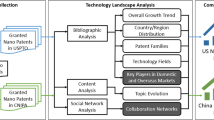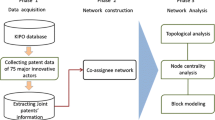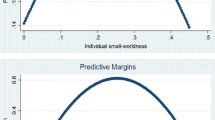Abstract
Using social network analysis to examine patenting data available at the USPTO, this paper explores an evolutionary process of global nanotechnology collaboration network from the perspective of entry and exit of collaborative organizations (nodes) and network’s preferential attachment process. The results show that the nanotechnology collaboration network evolved through frequent updates of the nodes and their relations (links). Compared with degree centrality and closeness centrality, betweenness centrality of an existing node was a significantly better predictor of the preferential attachment. The nodes with higher betweenness centrality were more influential to attract other nodes. This fact is observed while the network evolved. The results reveal that the core nodes with higher betweenness centrality were mostly large organizations that were equipped with core technology. They played an important broker role attracting more organizations into collaboration.




Similar content being viewed by others
Notes
Government includes the Ministry of International Trade and Industry (Tokyo, JP), National Research Council (Canada) (Ontario, CA), the United States of America as represented by the Secretary of Commerce (Washington, DC), Commissariat a L’ Energie Atomique (FR), and others.
References
Abbasi, A., Chung, K. S. K., & Hossain, L. (2012a). Egocentric analysis of co-authorship network structure, position and performance. Information Processing and Management, 48(4), 671–679.
Abbasi, A., Hossain, L., & Leydesdorff, L. (2012b). Betweenness centrality as a driver of preferential attachment in the evolution of research collaboration networks. Journal of Informetrics, 6(3), 403–412.
Albert, R., & Barabási, A. L. (2002). Statistical mechanics of complex networks. Reviews of Modern Physics, 74(1), 47–97.
Appelbaum, R. P., Parker, R., & Cao, C. (2011). Developmental state and innovation: Nanotechnology in China. Global Networks, 11(3), 298–314.
Autant-Bernard, C., Billand, P., Frachisse, D., & Massard, N. (2007). Social distance versus spatial distance in R&D cooperation: Empirical evidence from European collaboration choices in micro and nanotechnologies. Papers in Regional Science, 86(3), 495–519.
Balland, P. A., De Vaan, M., & Boschma, R. (2013). The dynamics of interfirm networks along the industry life cycle: The case of the global video game industry, 1987–2007. Journal of Economic Geography, 13(5), 741–765.
Barabási, A. L., & Albert, R. (1999). Emergence of scaling in random networks. Science, 286(5439), 509–512.
Barabási, A. L., Jeong, H., Néda, Z., Ravasz, E., Schubert, A., & Vicsek, T. (2002). Evolution of the social network of scientific collaborations. Physica A: Statistical Mechanics and its Applications, 311(3), 590–614.
Borgatti, S. P. (2005). Centrality and network flow. Social Networks, 27(1), 55–71.
Burt, R. S. (2004). Structural holes and good ideas. American Journal of Sociology, 110(2), 349–399.
Cantner, U., & Graf, H. (2006). The network of innovators in Jena: An application of social network analysis. Research Policy, 35(4), 463–480.
Cantner, U., & Rake, B. (2014). International research networks in pharmaceuticals: Structure and dynamics. Research Policy, 43(2), 333–348.
Cao, C., Appelbaum, R. P., & Parker, R. (2013). “Research is high and the market is far away”: Commercialization of nanotechnology in China. Technology in Society, 35(1), 55–64.
Cunningham, S. W., & Werker, C. (2012). Proximity and collaboration in European nanotechnology. Papers in Regional Science, 91(4), 723–742.
Davidsen, J., Ebel, H., & Bornholdt, S. (2002). Emergence of a small world from local interactions: Modeling acquaintance networks. Physical Review Letters, 88(12), 128–701.
Freeman, L. C. (1978). Centrality in social networks conceptual clarification. Social Networks, 1(3), 215–239.
Gay, B., & Dousset, B. (2005). Innovation and network structural dynamics: Study of the alliance network of a major sector of the biotechnology industry. Research Policy, 34(10), 1457–1475.
Goldberg, L. S. (2010). US–Japan collaborations in computer science/electrical engineering. In NSF Tokyo Office 50th anniversary symposium. https://www.nsf.gov/od/oise/tokyo/presentations/LGoldberg.pdf
Griliches, Z. (1990). Patent statistics as economic indicators: A survey (No. w3301). National Bureau of Economic Research.
Groves, C. (2013). Four scenarios for nanotechnologies in the UK, 2011–2020. Technology Analysis & Strategic Management, 25(5), 507–526.
Hong, W. (2008). Decline of the center: The decentralizing process of knowledge transfer of Chinese universities from 1985 to 2004. Research Policy, 37(4), 580–595.
Hong, W., & Su, Y. S. (2013). The effect of institutional proximity in non-local university–industry collaborations: An analysis based on Chinese patent data. Research Policy, 42(2), 454–464.
Huang, Z., Chen, H., Chen, Z. K., & Roco, M. C. (2004). International nanotechnology development in 2003: Country, institution, and technology field analysis based on USPTO patent database. Journal of Nanoparticle Research, 6(4), 325–354.
Islam, N., & Ozcan, S. (2013). Nanotechnology innovation system: An empirical analysis of the emerging actors and collaborative networks. IEEE Transactions on Engineering Management, 60(4), 687–703.
Jost, J., & Joy, M. P. (2002). Evolving networks with distance preferences. Physical Review E, 66(3), 36–126.
Jung, H. J., & Lee, J. J. (2014). The impacts of science and technology policy interventions on university research: Evidence from the U.S. National Nanotechnology Initiative. Research Policy, 43(1), 74–91.
Lei, X. P., Zhao, Z. Y., Zhang, X., Chen, D. Z., Huang, M. H., & Zhao, Y. H. (2011). The inventive activities and collaboration pattern of university–industry–government in China based on patent analysis. Scientometrics, 90(1), 231–251.
Leydesdorff, L. (2007). Betweenness centrality as an indicator of the interdisciplinarity of scientific journals. Journal of the American Society for Information Science and Technology, 58(9), 1303–1319.
Leydesdorff, L., & Zhou, P. (2007). Nanotechnology as a field of science: Its delineation in terms of journals and patents. Scientometrics, 70(3), 693–713.
Ma, Z., & Lee, Y. (2008). Patent application and technological collaboration in inventive activities: 1980–2005. Technovation, 28(6), 379–390.
Merton, R. K. (1968). The Matthew effect in science. Science, 159(3810), 56–63.
Meyer, M., & Persson, O. (1998). Nanotechnology-interdisciplinarity, patterns of collaboration and differences in application. Scientometrics, 42(2), 195–205.
Milojević, S. (2010). Modes of collaboration in modern science: Beyond power laws and preferential attachment. Journal of the American Society for Information Science and Technology, 61(7), 1410–1423.
Newman, M. E. (2003). The structure and function of complex networks. SIAM review, 45(2), 167–256.
Newman, M. E. (2008). The mathematics of networks. The New Palgrave Encyclopedia of Economics, 2, 1–12.
Onel, S., Zeid, A., & Kamarthi, S. (2011). The structure and analysis of nanotechnology co-author and citation networks. Scientometrics, 89(1), 119–138.
Pandza, K., Wilkins, T. A., & Alfoldi, E. A. (2011). Collaborative diversity in a nanotechnology innovation system: Evidence from the EU Framework Programme. Technovation, 31(9), 476–489.
Pisano, G. P. (1991). The governance of innovation: Vertical integration and collaborative arrangements in the biotechnology industry. Research Policy, 20(3), 237–249.
Porter, A. L., Youtie, J., Shapira, P., & Schoeneck, D. J. (2008). Refining search terms for nanotechnology. Journal of Nanoparticle Research, 10(5), 715–728.
Powell, W. W., Koput, K. W., & Smith-Doerr, L. (1996). Interorganizational collaboration and the locus of innovation: Networks of learning in biotechnology. Administrative Science Quarterly, 41(1), 116–145.
Powell, W. W., White, D. R., Koput, K. W., & Owen-Smith, J. (2005). Network dynamics and field evolution: The growth of interorganizational collaboration in the life sciences. American Journal of Sociology, 110(4), 1132–1205.
Schummer, J. (2004). Multidisciplinarity, interdisciplinarity, and patterns of research collaboration in nanoscience and nanotechnology. Scientometrics, 59(3), 425–465.
Shipilov, A. V., & Li, S. X. (2008). Can you have your cake and eat it too? Structural holes’ influence on status accumulation and market performance in collaborative networks. Administrative Science Quarterly, 53(1), 73–108.
Song, M., & Montoya-Weiss, M. M. (2001). The effect of perceived technological uncertainty on Japanese new product development. Academy of Management Journal, 44(1), 61–80.
Sun, Y., & Cao, C. (2015). Intra-and inter-regional research collaboration across organizational boundaries: Evolving patterns in China. Technological Forecasting and Social Change, 96, 215–231.
Tang, L., & Shapira, P. (2011a). China-US scientific collaboration in nanotechnology: Patterns and dynamics. Scientometrics, 88(1), 1–16.
Tang, L., & Shapira, P. (2011b). Regional development and interregional collaboration in the growth of nanotechnology research in China. Scientometrics, 86(2), 299–315.
Wagner, C. S., & Leydesdorff, L. (2005). Network structure, self-organization, and the growth of international collaboration in science. Research Policy, 34(10), 1608–1618.
Wang, C. H., & Chien, P. Y. (2013). Exploring the nanotechnology alliances of nanotechnology firms: The roles of network position and technological uncertainty. Science Technology & Society, 18(2), 139–164.
Wang, G., & Guan, J. (2010). The role of patenting activity for scientific research: A study of academic inventors from China’s nanotechnology. Journal of Informetrics, 4(3), 338–350.
Weng, C. S., Yang, W. G., & Lai, K. K. (2014). Technological position in alliances network. Technology Analysis & Strategic Management, 26(6), 669–685.
Wilsdon, J. (2011). Knowledge, networks and nations: Global scientific collaboration in the 21st century. London: The Royal Society.
Wong, P. K., Ho, Y. P., & Chan, C. K. (2007). Internationalization and evolution of application areas of an emerging technology: The case of nanotechnology. Scientometrics, 70(3), 715–737.
Wuchty, S., Jones, B. F., & Uzzi, B. (2007). The increasing dominance of teams in production of knowledge. Science, 316(5827), 1036–1039.
Youtie, J., & Kay, L. (2014). Acquiring nanotechnology capabilities: Role of mergers and acquisitions. Technology Analysis & Strategic Management, 26(5), 547–563.
Zhang, H., Qiu, B., Ivanova, K., Giles, C. L., Foley, H. C., & Yen, J. (2010). Locality and attachedness-based temporal social network growth dynamics analysis: A case study of evolving nanotechnology scientific collaboration networks. Journal of the American Society for Information Science and Technology, 61(5), 964–977.
Zhao, Q., & Guan, J. (2011). International collaboration of three ‘giants’ with the G7 countries in emerging nanobiopharmaceuticals. Scientometrics, 87(1), 159–170.
Zheng, J., Zhao, Z. Y., Zhang, X., Chen, D. Z., & Huang, M. H. (2014). International collaboration development in nanotechnology: A perspective of patent network analysis. Scientometrics, 98(1), 683–702.
Acknowledgements
This research has been supported by grants from the National Natural Science Foundation of China (71473026 and 71673037). Cao’s work has been partially supported by grants from the U.S. National Science Foundation (SES-0531184 and SES-0938099).
Author information
Authors and Affiliations
Corresponding author
Rights and permissions
About this article
Cite this article
Liu, F., Zhang, N. & Cao, C. An evolutionary process of global nanotechnology collaboration: a social network analysis of patents at USPTO. Scientometrics 111, 1449–1465 (2017). https://doi.org/10.1007/s11192-017-2362-6
Received:
Published:
Issue Date:
DOI: https://doi.org/10.1007/s11192-017-2362-6




